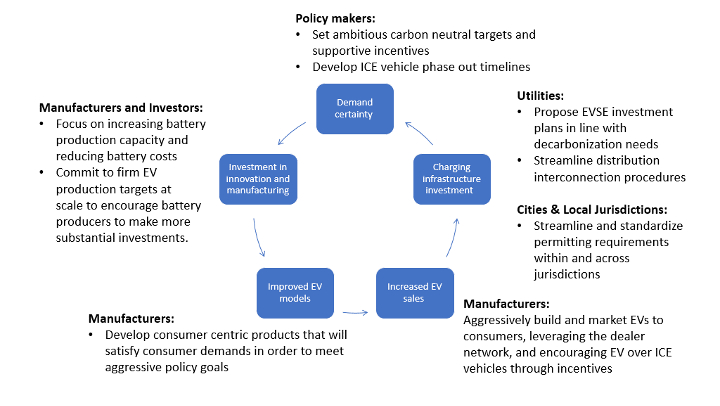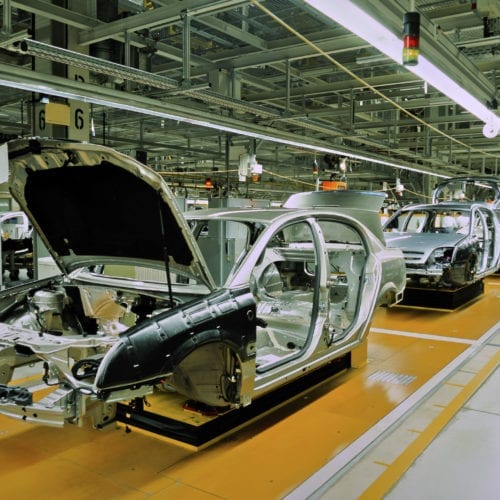by Larisa Koshkina, public domain

Now Is the Time for US Leadership on Electric Vehicles
Transportation is the United States’ largest source of greenhouse gas emissions. Estimates suggest that to keep the world within 1.5°C of warming, at least one in five cars must be electric by 2030, in addition to decreasing vehicle miles traveled. Recent announcements about technology improvements and demand signals herald irreversible industry growth. Policymakers, utilities, manufacturers, and investors must meet this moment by anticipating the rapid rate of non-linear change and setting ambitious goals, based on what is needed for a zero-emissions mobility system by 2050.
Milestones in the Fast Lane
The pace of change for US vehicle electrification has picked up in the past two months. Here are some milestones since the beginning of September, that herald bigger changes to come.
- 9/3 Battery maker QuantumScape announces its IPO
- 9/8 Duke Energy pledges to electrify vehicle fleet
- 9/9 Lucid Air reveals sedan with 500 miles of range, on a single battery charge
- 9/22 Tesla announces million-mile battery goal and “tabless” batteries, to be produced in-house
- 9/23 CA Governor announces order to phase out ICE sales by 2035
- 10/8 Amazon reveals electric delivery vehicle
- 10/19 New Jersey DEP announced plan to phase out ICE sales by 2035
The Technology Has Arrived
Tesla’s new battery cell suggests that affordable high-performance EVs will arrive sooner than expected. Innovations such as the “tabless” cell design will enable larger cells that will significantly improve vehicle range, while simultaneously reducing costs per unit of energy stored. Combined with other manufacturing innovations such as dry electrode coating and initial cell charging (cell formation), Tesla expects to offer high-quality long-range EVs that cost $25,000 by 2023.
Rapid battery technology improvements make it easier to design vehicles that meet American preferences for long-range vehicles. Many manufacturers now offer EV models with a range of more than 200 miles. Solid-state battery technology promises to further extend range, even in cold environments. QuantumScape, a solid-state battery technology company backed by Bill Gates and Volkswagen, recently announced its intention to have an initial public offering by the end of 2020, suggesting that the technology is edging closer to commercial readiness.
Demand Is Up
On September 23, California Governor Newsom delivered one of the most compelling demand signals yet: an order instructing the California Air Resources Board to establish rules for phasing out internal combustion engine (ICE) passenger vehicle sales in the state by 2035. This milestone is meaningful for many reasons.
California has historically led the nation on innovative climate policies and programs, such as the Zero-Emission Vehicle program that 11 other states copied. Other states are already indicating that they may follow suit. This includes New Jersey, where the Department of Environmental Protection has announced plans to phase out ICE vehicles by 2035 as well.
Also, 10 percent of all new light-duty vehicles in the United States are registered in California, which means that global manufacturers will have a strong incentive to produce and sell electric vehicles that meet US consumer preferences for larger, more powerful vehicles. Electric SUVs and pick-up trucks are increasingly being unveiled, including Ford’s recent announcement that it will domestically manufacture an all-electric F-150 by 2022.
In addition to ICE bans and ZEV mandates, corporate commitments and partnerships on fleet electrification are providing market confidence for electric vehicle manufacturers. Electric vehicles already have lower lifetime operations and maintenance costs, which means economic savings. This is especially true for high utilization vehicles, such as Lyft and Uber. Both have announced plans to fully electrify their US fleets by 2030.
The companies making these commitments include the world’s largest retailers. This week Amazon debuted its custom fully electric delivery vehicle just one year after announcing that it would order 100,000 electric delivery vans from electric truck maker Rivian. And Walmart, which has a fleet of more than 70,000 vehicles, also has a plan to electrify its fleet—including long-haul trucking by 2040. Other shipping and logistics companies such as UPS and FedEx have made similar commitments.
Even companies in historically less innovative sectors, such as waste management firm Republic Services, are recognizing that this is a critical moment and are making investments that will keep them competitive in the future. Many major utilities such as Southern Company, Alliant, PNM, FirstEnergy, Portland General Electric, and Duke Energy have announced their intention to electrify their own fleets in addition to supporting the integration of EVs and EV-charging infrastructure throughout their service territories. These commitments and others represent an exponential scale-up of demand for electric vehicle models and are acting as fuel that continues to spread the race for competitive electric vehicle fleet adoption.
Charging Infrastructure Investment
As the EV market takes off, planners and investors must consider how to scale the charging infrastructure. Colorado’s Electric Vehicle Plan 2020 combines a vision for high EV adoption and a transportation plan to decrease total vehicle miles traveled. This plan has already helped spur Xcel Energy to take their targets to the next level by proposing an investment in charging infrastructure that will power the needs of 1.5 million EVs, or one in five vehicles on the road in Xcel Energy’s service territory, by 2030.
While numerous articles have pointed out that charging infrastructure is a large and looming challenge for meeting California Governor Newsom’s ICE phaseout order, the state is far ahead of other states with important right to charge legislation. This requires landlords to allow tenants to install EV chargers, requires utilities to cover the costs of infrastructure on the utility side of the meter, and approves large utility charging infrastructure investment programs.
Policy makers, manufacturers, utilities, investors, and businesses should plan for rapid change, based on climate goals. Reinforcing feedback suggests that change is coming quickly, and other countries have a starting advantage on the US market. Policies and commitments that provide demand certainty should lead to technology and product improvements which increase EV adoption and spur governments and investors to make further infrastructure investments. Demand certainty in other parts of the world, especially China and the EU, has already attracted enormous capital flows into finding breakthroughs in battery technologies and scaling manufacturing.

However, the United States doesn’t have to be at a disadvantage if it seizes the moment. It has one of the largest vehicle markets in the world, a lucrative prize by any means. The US market must move fast enough to remain competitive and to address the climate crisis. As other geographies tie their electric vehicle plans to what is needed for a decarbonized world, manufacturers, investors, policy makers, and utilities must consider mobility decarbonization as their metric for competitive success.

